TURGIDA Rose, 1905
Series Urbiniae
Type : C.A. Purpus / Rose 962. Collected on limestone rock near Viesca, Coahuila, Mexico, February 20, 1904.
Etymology : Lat. turgidus = swollen, referring to the leaves.
Distribution: Mexico (Coahuila: from Viesca to Cuatrocienegas Basin)
First Description by Rose, North American Flora 22 : 21. 1905 :
Acaulescent.
Leaves very numerous, forming very compact rosettes, very turgid, spatulate-oblong, mucronate-tipped, greyish-green, somewhat glaucous, the tips and margin more or less tinged with red.
Flowering stems about 10 cm long, red above, paler below, bracts 6 – 8 mm long, acute, narrow, semiterete, flowers 4 – 6 in a secund raceme, lower pedicels 6 – 8 mm long, the upper ones gradually shorter.
Flowers : Sepals spreading at right angles to the corolla-tube, the larger ones 6 mm long, the two smaller minute, corolla rose-colored, 5-angled, 10 mm long, its lobes pointed.
Cytology : n = 31.
Note :
1. The name E. turgida has been and still is misused for various somewhat similar plants, species as well as hybrids.
2. E. turgida has been offered twice by ISI :
- as n° 298 in 1959 : "a small, waxy looking rosette, pale blue grey in colour with each incurved leaf tip coming to a sharp red tipped point". Collector and locality unknown, determined as E. turgida by E. Walther - that means a rather doubtful plant. And
- as n° 912 in 1975 : Rooted cuttings of plants collected at the type locality.
3. Walther's re-description of E. turgida (Echeveria 141-143, 1972) was made "from material long cultivated in California gardens" - which means from plants without known origin - as a result it differs from the protologue in several aspects, for ex. in much longer pedicels. It is useless as is also the summary by Kimnach in the Illustrated Handbook of Succulent Plants, 2003.
4. For more details see p. 110-111 in Revision of Walther's monograph Echeveria, 1972.




Plant in cultivation :

Photos Gerhard Köhres